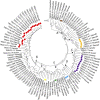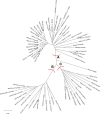Genomic and comparative analysis of the T cell receptor gamma locus in two Equus species
- PMID: 37781375
- PMCID: PMC10540303
- DOI: 10.3389/fimmu.2023.1264949
Genomic and comparative analysis of the T cell receptor gamma locus in two Equus species
Abstract
The genus Equus is the only extant genus of the Equidae family, which belongs to Perissodactyla, an order of mammals characterized by an odd number of toes (odd-toes ungulates). Taking advantage of the latest release of the genome assembly, we studied, for the first time in two organisms belonging to the Equus genus, the horse (Equus caballus) and the donkey (Equus asinus), the T cell receptor gamma (TRG) locus encoding the gamma chain of the γδ T cell receptor. Forty-five Variable (TRGV) genes belonging to the seven IMGT-NC validated mammalian TRGV subgroups, 25 Joining (TRGJ) and 17 Constant (TRGC) genes organized in 17 V-J-(J)-C cassettes, in tandem on about 1100 Kb, characterize the horse TRG locus, making the horse TRG locus the one with the greatest extension and with a significantly higher number of genes than the orthologous loci of the other mammalian species. A clonotype analysis of an RNA-seq transcriptomic dataset derived from spleen of an adult healthy horse, using the complete set of the horse TRGJ germline gene sequences as a probe, revealed that, in addition to the most prominent V-J rearrangements within each cassette, there is a relevant proportion of trans-cassette V-J recombination, whereby the same TRGV genes can recombine with different TRGJ genes spliced to the corresponding TRGC genes. This recombinant event strongly contributes to the diversity of the γ chain repertoire. In the donkey TRG locus, 34 TRGV, 21 TRGJ and 14 TRGC genes distributed in 14 V-J-(J)-C cassettes were found in a region of approximately 860 kb. Although the donkey's TRG is smaller than that of the horse, in Equus genus, this is still the second largest locus so far found in any mammalian species. Finally, the comparative analysis highlighted differences in size and gene content between the horse and donkey TRG loci, despite belonging to the same genus, indicating a good level of diversification within Equus. These data is in agreement with the evolutionary idea of the existence of a Equus recent common ancestor in rapid evolution, for which a mutation rate between horses and donkeys is more comparable to that between species belonging to different genera rather than to species of the same genus.
Keywords: Equus; Perissodactyla; TRG genes; TRG locus; equid genome; evolution; gamma-delta T-cell; immunogenomics.
Copyright © 2023 Massari, Giannico, Paolillo, Pala, Jambrenghi and Antonacci.
Conflict of interest statement
The authors declare that the research was conducted in the absence of any commercial or financial relationships that could be construed as a potential conflict of interest.
Figures






References
-
- Lefranc M-P, Lefranc G. The T Cell Receptor FactsBook. San Diego, CA, USA: Academic Press Harcourt Science and Technology Company; (2001).
Publication types
MeSH terms
Substances
LinkOut - more resources
Full Text Sources

